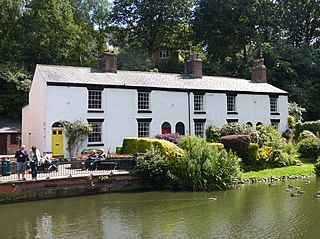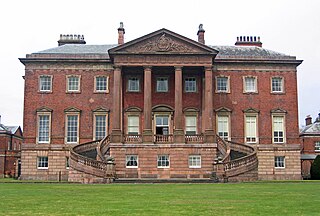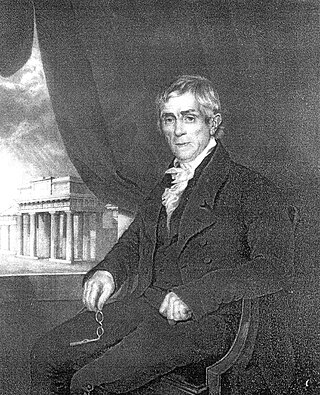Oughtrington Hall was a country house located in Oughtrington Lane to the east of the village of Lymm in Cheshire, England.
The manor house was rebuilt in about 1810 for Trafford Trafford (né Leigh: a descendant of the ancient Leighs of West Hall, High Legh), who assumed the surname and arms of Trafford by Royal Licence 5 December 1791 in compliance with the Will of his maternal uncle Richard Trafford, of Swythamley. [1] [lower-alpha 1]
In 1862 Oughtrington Hall was bought by G. C. Dewhurst, a cotton manufacturer from Manchester. Dewhurst enlarged the service wing and also paid for the construction of St Peter's Church nearby. [3]
Built in the neoclassical architectural style, it is rendered of brick with stone dressings and a slate roof. [3] [4] At the centre of the entrance front is a wide canted bay containing a porch with paired Tuscan columns. On each side of the porch are three-light windows under a segmental arch. [3]
The former mansion now forms the main building of Lymm High School, [5] [4] and is designated in the National Heritage List for England as a Grade II listed building. [4]

Lymm is a village and civil parish in the Borough of Warrington, Cheshire, England. It incorporates the hamlets of Booths Hill, Broomedge, Church Green, Deansgreen, Heatley, Heatley Heath, Little Heatley, Oughtrington, Reddish, Rushgreen and Statham. At the 2021 United Kingdom census it had a population of 12,700. The village is situated in the northern aspect of Cheshire and borders Greater Manchester to the East and lies 1 mile from the border of Salford to the north.

Tabley House is an English country house in Tabley Inferior, some 3 kilometres (1.9 mi) to the west of the town of Knutsford, Cheshire. The house is recorded in the National Heritage List for England as a designated Grade I listed building. It was built between 1761 and 1769 for Sir Peter Byrne Leicester, to replace the nearby Tabley Old Hall, and was designed by John Carr. The Tabley House Collection exists as an exhibition showcased by the University of Manchester.

Thomas Harrison was an English architect and bridge engineer who trained in Rome, where he studied classical architecture. Returning to England, he won the competition in 1782 for the design of Skerton Bridge in Lancaster. After moving to Lancaster he worked on local buildings, received commissions for further bridges, and designed country houses in Scotland. In 1786 Harrison was asked to design new buildings within the grounds of Lancaster and Chester castles, projects that occupied him, together with other works, until 1815. On both sites he created accommodation for prisoners, law courts, and a shire hall, while working on various other public buildings, gentlemen's clubs, churches, houses, and monuments elsewhere. His final major commission was for the design of Grosvenor Bridge in Chester.

Lymm High School is a secondary school and sixth form with academy status, located in Lymm, Warrington, Cheshire.

St Mary's Church is the Anglican parish church of Lymm, Warrington, Cheshire, England, standing on a bank overlooking Lymm Dam. It is a grade II listed building. It is an active church in the diocese of Chester, the archdeaconry of Chester and the deanery of Great Budworth.

St Peter's Church is the parish church of Lymm in Warrington, Cheshire, England. The church is recorded in the National Heritage List for England as a designated Grade II listed building. It is an active Anglican parish church in the diocese of Chester, the archdeaconry of Macclesfield and the deanery of Bowdon. Its benefice is combined with that of St Werburgh, Warburton.
Burford Lane Farmhouse is in Burford Lane in the village of Oughtrington, near Lymm, Cheshire, England. It is recorded in the National Heritage List for England as a designated Grade II listed building.

Birtles Hall is a country house in the parish of Over Alderley, Cheshire, England. It was built in about 1819 for the West Indies merchant Robert Hibbert.
Bulkeley Grange is a country house to the southeast of the village of Bulkeley, Cheshire, England. It replaced an earlier timber-framed house on the site, Bulkeley Old Hall, built by Thomas Brassey in about 1600. Bulkeley Grange was built in about 1865 by his successor and namesake, the railway contractor Thomas Brassey for his brother, Robert Brassey, as a model farm. The house is constructed in red brick with slate roofs in Jacobean style. Some half-timbering has been applied to the exterior. The entrance front is in two storeys and three bays with gables. It has a large, mainly stone, projecting porch with Jacobean-style pilasters and an openwork parapet. The house is recorded in the National Heritage List for England as a designated Grade II listed building.

Cranage Hall is a former country house in the village of Cranage, Cheshire, England. It was built in 1828–29 for Lawrence Armitstead, and designed by Lewis Wyatt. In 1932 a parallel wing was added. Since the hospital closed, it has been used as a hotel and conference centre owned and run by the Principal Hayley hotel group. The building is constructed in red brick with blue brick diapering, and in yellow sandstone. It is roofed in slate. The architectural style is Elizabethan. The building is in two storeys plus a basement, and it has eight bays. The first and fourth bays are in stone; the others are in brick. In front of the sixth and seven bays is a two-storey stone porch with four fluted Doric columns, an entablature with a frieze, and a balcony with an openwork balustrade. Between the third and fourth bays is a slim octagonal tower with an ogee cap and a weathervane. The house is recorded in the National Heritage List for England as a designated Grade II listed building.
Crewood Hall is a country house to the northeast of the village of Kingsley, Cheshire, England. It dates from the 16th century, and has a porch dated 1638. Initially timber-framed, the building was encased in brick and remodelled in the 19th century. It has stone dressings and tiled roofs, and is in two storeys. The house consists of a hall with two cross wings and a two-storey porch at the end of the left wing. The lower storey of the porch is in sandstone and in the upper storey the timber-framing is exposed. The house is recorded in the National Heritage List for England as a designated Grade II* listed building. Associated with the house, and also listed at Grade II, are two farm buildings; stables, and a shippon and barn.

Davenham Hall is a former country house to the southeast of the village of Davenham, Cheshire, England. It was built for Thomas Ravenscroft to replace a timber-framed house called Davenham Lodge. It dates from the middle or the later part of the 18th century, possibly from shortly before 1795, when Ravenscroft died. Substantial additions were made in the early 19th century. It is constructed in stuccoed brick, and has a slate roof. The house is in two storeys with a symmetrical entrance front of six bays. Occupying the middle two bays is a porch with four Tuscan columns and an entablature containing a triglyph. Above this, the central bays protrude slightly forwards and contain two windows, with a pediment above them and a parapet on each side. Figueirdo and Treuherz describe the interior as being "especially fine". The entrance hall contains Grecian plasterwork and a black marble chimneypiece. The drawing room has more delicate plasterwork, and a marble chimneypiece decorated with dancing figures. The central staircase hall is lit by a central dome, and has fan-shaped plasterwork. The staircase has a wrought iron baluster, and the first floor landing has a screen of four Doric columns. The house was converted into a nursing home in 1980. It is recorded in the National Heritage List for England as a designated Grade II* listed building.

Hartford Manor is a former country house in the village of Hartford, Cheshire, England. Its age is uncertain; it was said to have been re-fronted in about 1820 for John Marshall, but the core of the building is earlier. It has since been altered and extended. During the 20th century the building was used an office. It one time it was used by North West Gas; as of 2011 it is the office of Holidaybreak. The house is constructed in yellow ashlar stone, and it has a hipped slated roof. Its front is symmetrical with two storeys and five bays. The central bay is slightly bowed, and contains a portico with two Doric columns and a flat entablature. It is recorded in the National Heritage List for England as a designated Grade II listed building. It is now used for office accommodation.

Hoole Hall is a former country house located to the north of Chester, Cheshire, England. It originated as a small house in about 1760, built for the Rev John Baldwin. After Rev Baldwin's death in 1793, the house passed to his eldest son, Thomas Baldwin, who then sold the house and surrounding land in 1800.
Ingersley Hall, later Savio House, stands to the east of the town of Bollington, Cheshire, England. The house was built in about 1775 for John Gaskell. Extensions were added to it in 1833 for John Upton Gaskell. The house was sold by the Gaskell family in 1933. In the 1950s it was taken over by a religious order, the Salesians of Don Bosco, and renamed Savio House. As of 2011 the house is used as a retreat and activities centre for young people. The front of the house is constructed in ashlar, with the remainder in coursed sandstone rubble. The house is roofed in Welsh slate and has stone chimneys. It has a rectangular plan and is in two storeys. The architectural style is Greek Revival. The north front is symmetrical with five bays divided by pilasters. The porch is in Doric style. The west front has eight bays, the central three of which were in the original house. All the windows in the north and west fronts are sashes with 12 panes. The south door is in Tuscan style, and was probably moved from the west front. The house is recorded in the National Heritage List for England as a designated Grade II listed building. Also listed at Grade II is a former coach house to the south of the hall, built in about 1850, and converted into a conference hall in about 1950.
Lymm Hall is a moated country house in the village suburb of Lymm in Warrington, Cheshire, England. It is recorded in the National Heritage List for England as a designated Grade II* listed building.

Trafford Hall is an 18th-century country house standing to the east of the village of Wimbolds Trafford in Cheshire, England, about 4+1⁄2 miles (7 km) northeast of the city of Chester. It is owned by The Regenda Group and operated as a youth hostel and training centre by the Youth Hostels Association.
Tushingham Hall is a country house in Tushingham, Cheshire, England. Formerly a moated farmhouse, it was remodelled in the early 19th century for Daniel Vawdrey, retaining many 17th-century features. It is constructed in rendered brick with slate roofs. Its architectural style is Tudor Revival. The house is in two storeys with a symmetrical entrance front. The centre of the front is recessed and contains a canted open porch with three Tudor arches. Above this is a mullioned window containing two sashes. On each side is a similar window in both storeys, those in the upper storey being smaller than those below. Above the window over the porch is a shaped gable containing a wreath, and the rest of the front is crenellated. The interior contains a 17th-century staircase originally in Dearnford Hall, Staffordshire. The house is recorded in the National Heritage List for England as a designated Grade II listed building.

In the English civil parish of Lymm, there are 55 buildings that are recorded in the National Heritage List for England as designated listed buildings. Of these, one is classified as Grade I and one as Grade II*; the remainder are at Grade II. Lymm is in the borough of Warrington and the ceremonial county of Cheshire. In the early 16th century, the civil parish was a prosperous agricultural area, divided into two manors, Lymm and Oughtrington. The Grade-II*-listed Lymm Hall, the oldest listed building in the civil parish, dates from the late 16th century and occupies the site of a medieval building which was the manorial seat. The largest settlement in the civil parish is Lymm, which has expanded into a small town whilst retaining its village centre. Several other small settlements within the parish remain separate, including Oughtrington; Oughtrington Hall dates from around 1810.
53°22′43″N2°27′34″W / 53.37867°N 2.45951°W